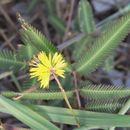Comprehensive Description
provided by North American Flora
Neptunia pubescens Benth. Journ. Bot. Hook. 4: 356. 1841
Neptunia lloridana Small. Bull. Torrey Club 25: 138. Mr. 1898.
Neptunia Lindheimeri B. L. Robinson, Proc. Am. Acad. 33: 333. My. 1898.
Pubescent or glabrate, the slender stems prostrate or ascending, 2-7 dm. long. Stipules lanceolate to ovate-lanceolate, acuminate, 2-3 mm. long; petioles slender, glandless, 1-3 cm. long; pinnae 2-5 pairs; leaflets 15-35 pairs, oblong or linear-oblong, obtuse, acutish or mucronulate, 3-5 mm. long, glabrous, or ciliate, or sometimes puberulent beneath; peduncles slender, 2-5 cm. long; heads globose or short-oblong, about 6 mm. thick, exclusive of the stamens; calyx and bractlets glabrous or ciliolate; calyx about 1.5 mm. long; legume oblong, obtuse or rounded, glabrous, or sparingly puberulent when young, short-stipitate, 2-3.5 cm. long, 6-8 mm. wide.
Type locality: Lima. Peru.
Distribution: Florida to Texas; Cuba; Hispaniola; Antigua; Guadeloupe; Martinique; Dominica; Panama. Peru. Paraguay.
- bibliographic citation
- Nathaniel Lord Britton and Joseph Nelson Rose. 1928. (ROSALES); MIMOSACEAE. North American flora. vol 23(1). New York Botanical Garden, New York, NY
Comprehensive Description
provided by North American Flora
Neptunia mazatlana Britton & Rose, sp. nov
Stems several from a woody root, slender, glabrous, spreading, 2-3 dm. long. Stipules ovate, acute or acuminate, 3-5 mm. long; petioles slender, eglandular, about 1.5 cm. long or shorter; pinnae 1-3 pairs, short-stalked; leaflets 3-11 pairs, oblong-obovate, the lower pair about 2 mm. long, the others 3-3.5 mm. long, the apex rounded, the nearly central midvein prominent beneath, the few lateral veins indistinct, the margins long-ciliate; peduncles very slender, 2-3 cm. long, bearing 1 or 2 small lanceolate membranous bracts; heads oblong, several-flowered, about 5 mm. long; bractlets lanceolate, acuminate, 1 mm. long; calyx 1.5 mm. long; young legumes short-stipitate.
Sand hills, vicinity of Mazatlan, Sinaloa, April 4, 1910, Rose, Standley & Russell 14001.
- bibliographic citation
- Nathaniel Lord Britton and Joseph Nelson Rose. 1928. (ROSALES); MIMOSACEAE. North American flora. vol 23(1). New York Botanical Garden, New York, NY
Physical Description
provided by USDA PLANTS text
Perennial, Herbs, Stems woody below, or from woody crown or caudex, Taproot present, Nodules present, Plants stoloniferous, Stems prostrate, trailing, or mat forming, Stems less than 1 m tall, Stems solid, Stems or young twigs glabrous or sparsely glabrate, Stems or young twigs sparsely to densely hairy, Leaves alternate, Leaves petiolate, Stipules conspicuous, Stipules green, triangulate to lanc eolate or foliaceous, Stipules persistent, Stipules free, Leaves compound, Leaves bipinnate, Leaf or leaflet margins entire, Leaflets opposite, Leaflets 10-many, Leaves hairy on one or both surfaces, Inflorescences spikes or spike-like, Inflorescences globose heads, capitate or subcapitate, Inflorescence axillary, Bracts conspicuously present, Flowers actinomorphic or somewhat irregular, Calyx 5-lobed, Calyx glabrous, Petals united, valvate, Petals orange or yellow, Stamens 9-10, Stamens completely free, separate, Stamens long exserted, Filaments glabrous, Style terete, Fruit a legume, Fruit stipitate, Fruit unilocular, Fruit freely dehiscent, Fruit elongate, straight, Fruit oblong or ellipsoidal, Fruit coriaceous or becoming woody, Fruit exserted from calyx, Fruit glabrous or glabrate, Fruit 3-10 seeded, Seed with elliptical line or depression, pleurogram, Seeds ovoid to rounded in outline, Seed surface smooth, Seeds olive, brown, or black.

